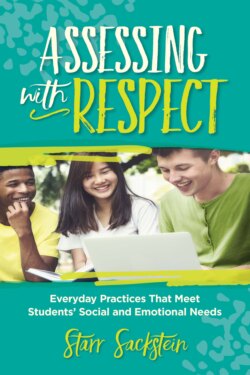Читать книгу Assessing with Respect - Starr Sackstein - Страница 16
На сайте Литреса книга снята с продажи.
Figure 1.4. Icebreaker Activity: "Find Someone Who …"
ОглавлениеThis icebreaker can be done in a number of ways. Students can interview their classmates to find out which items apply to them and have them sign or initial the item, or the items can be presented as a Bingo grid. Depending on the age of the students, you can adjust the specifics to things that they would likely have done.
Find someone who …
1. Traveled this summer
2. Loves to read
3. Knows what they want to be when they grow up
4. "Lives" on social media
5. Watches sports on TV
6. Plays a sport
7. Plays a musical instrument
8. Loves to eat
9. Is into fitness
10. Loves baseball
11. Travels by public transportation to school
12. Is a morning person
13. Loves coffee
14. Is an only child
15. Has a pet
16. Saw at least two movies this summer
17. Watches reality television
18. Plays Candy Crush or Trivia Crack
19. Has attended a sporting event
20. Has been to another country
21. Has a job
22. Loves the beach
23. Knows what college they would like to attend
24. Likes vegetables
25. Has a best friend in this class
26. Knows how to ride a bike
27. Writes a blog/considers themselves a writer
28. Wants to change the world
29. Is interested in politics
30. Has read a classic novel
31. Loves technology
32. Knows how to use phones for learning
33. Can work with their hands
34. Lives with extended family
35. Can speak another language
Of course, the first week of school isn't the only opportunity you will have to make an impression and build relationships; it's just the start. Remember to stay consistent but flexible as you get to know your kids better. Pay attention to body language and who students spend time with. Become aware of which students are more assertive than others, and find classroom roles that will allow them to feel like leaders without dominating to the point of excluding other voices. Notice which students are inherently quiet, and engage in conversations to understand why this is so. Don't allow students who are somewhere in between to sit patiently while others carry the weight. Talk with individual students on their way in and out of class, asking about their day or weekend and expressing genuine interest in their answers.
During the first month of school, conduct a learning assessment that allows students to share how they learn best. Various websites include surveys that students can take to help them articulate how they like to learn, such as EducationPlanner.org. Surveys such as these can be a starting point for students who may have trouble articulating their learning preferences.
Regardless of the content you teach, ask students to write a short piece or draw a picture about themselves or an experience they have had that they think will help you better understand them as a person and a learner. Note what they share, and ask clarifying questions. As a model, share something you've written yourself that tells them what you want them to know about you as a person and a teacher. You don't need to share too much personal information, but the more open you are, the more students will open up to you.
